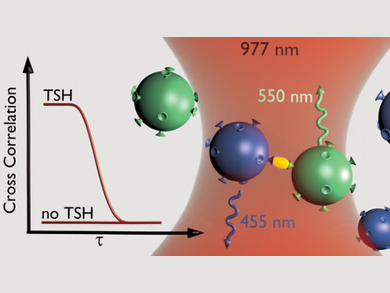Fluorescence correlation and cross‐correlation spectroscopy (FCS/FCCS) allow studying processes of transport, binding, and enzymatic reactions in living cells. FCS/FCCS is based on measuring fluorescence fluctuations in a diffraction‐limited volume of a few femtoliters. Therefore, it allows detecting dye concentrations down to the single molecule level (usually sub‐nanomolar). However, when it comes to strong autofluorescent samples, for example, blood or plasma, the FCS/FCCS signal of sub‐nanomolar probe concentrations can vanish in the spectrally overlapping autofluorescence background.
Tero Soukka, University of Turku, Finland, Tom Vosch, University of Copenhagen, Denmark, and colleagues have used upconversion cross‐correlation spectroscopy (UCCS). Cross‐correlation spectroscopy is based on two upconversion nanoparticles (UCBPs) which emit at different wavelengths on the anti‐Stokes side of a single excitation laser. UCCS allow to completely remove all Stokes shifted autofluorescence background in biological material such as plasma.
To demonstrate the potential of UCCS, the team used a homogeneous thyroid stimulating hormone (TSH) sandwich immunoassay. The assay is based on anti‐TSH antibody‐conjugated green- (NaYF4:Yb3+,Er3+) and blue-emitting (NaYF4:Yb3+,Er3+) UCNPs. In the assay, simultaneous emission of the two differently emitting UCNPs was detected during sandwich formation with the TSH analyte. The cross‐correlation amplitude of the two channels serves as an indicator for the formation of the sandwich complex between the two nanoparticles and the analyte. Upconversion emission detection enabled measurements completely free from autofluorescence in a buffer and in plasma. However, the detectability of TSH in plasma was degraded by the aggregation of UCNPs.
The study demonstrates the use of the UCNP labels for UCCS and the great potential of UCCS for samples and environments challenging for conventional FCCS measurements. In addition, according to the researchers, their concept is not restricted to in vitro immunoassays, but has potential also to in vivo applications, for example, in cells. Improvements in particle surface chemistry to prevent aggregation and non‐specific interactions would reduce the current limitations of UCCS in their opinion.
- Upconversion Cross-Correlation Spectroscopy of a Sandwich Immunoassay,
Satu Lahtinen, Stefan Krause, Riikka Arppe, Tero Soukka, Tom Vosch,
Chem. Eur. J. 2018.
https://doi.org/10.1002/chem.201801962



